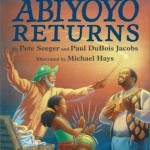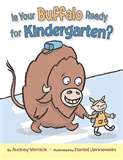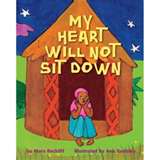Abiyoyo and Abiyoyo Returns
 It’s almost Halloween, and you want a book to share with your students that will give them shivers, but not nightmares. Pull out these picture books about a scary giant and the clever little boy who defeats him, and you’ll be hitting the Common Core State Standard of Integrating Knowledge and Ideas while you thrill your listeners.
It’s almost Halloween, and you want a book to share with your students that will give them shivers, but not nightmares. Pull out these picture books about a scary giant and the clever little boy who defeats him, and you’ll be hitting the Common Core State Standard of Integrating Knowledge and Ideas while you thrill your listeners.
Inspired by a South African folktale, Abiyoyo is a storysong written by the folk music master Pete Seeger and illustrated by Michael Hays. A little boy is always in trouble for making noise with his music. His father is shunned by the neighbors for playing too many pranks, making things disappear with his magic wand. But when fearful Abiyoyo comes, the little boy sings until the giant falls down from dancing, and the father uses his magic wand to make Abiyoyo disappear.
 Compare this classic to its sequel, Abiyoyo Returns written by Pete Seeger and Paul DuBois Jacobs, and illustrated by Michael Hays. The little boy who made Abiyoyo disappear is now a grown man, and his town needs a giant’s help. With the help of the magic wand, Abiyoyo returns and the townspeople teach him to help rather than to harm.
Compare this classic to its sequel, Abiyoyo Returns written by Pete Seeger and Paul DuBois Jacobs, and illustrated by Michael Hays. The little boy who made Abiyoyo disappear is now a grown man, and his town needs a giant’s help. With the help of the magic wand, Abiyoyo returns and the townspeople teach him to help rather than to harm.
There’s a terrific “Reading Rainbow” video of Pete Seeger telling/singing the first book (available for free on Youtube) and an audio cd available as well. Share the audio recording of Abiyoyo along with the book so your students can listen to a master storyteller. (You’ll enjoy listening to him as much as your students do, and it’s amazing how listening to a different voice than the one they hear all the time can perk up ears during a read-aloud.) Before reading Abiyoyo Returns, predict with your students how the people will handle Abiyoyo when he comes back. Contrast how Abiyoyo is the problem in one story and the solution in the other.For a fun art extension, get dowels from the hardware store (you can find them for less than $1 – cut them in half and they’re even less expensive!) and decorate your own magic wands. If your students are plagued with Halloween wiggles, let them sing the Abiyoyo song and dance around until they fall down. When you wave your wand to magically transport students back to their seats, their Halloween wiggles will have vanished!
Read MoreIs Your Buffalo Ready for Kindergarten?
 It’s August, and there’s one big question everyone has been asking: Is Your Buffalo Ready for Kindergarten? Thank goodness Audrey Vernick and Daniel Jennewein have made this fantastic book to help us find the answer. First of all, does your buffalo have a backpack? Yes? Well then, your buffalo is good to go! Tell your buffalo not to worry about being the only one in class with horns and a hump – your buffalo can be proud of being the state animal for Oklahoma! And, as author Vernick reminds us, one of the things we learn in kindergarten is that everyone is special in his or her own way.
It’s August, and there’s one big question everyone has been asking: Is Your Buffalo Ready for Kindergarten? Thank goodness Audrey Vernick and Daniel Jennewein have made this fantastic book to help us find the answer. First of all, does your buffalo have a backpack? Yes? Well then, your buffalo is good to go! Tell your buffalo not to worry about being the only one in class with horns and a hump – your buffalo can be proud of being the state animal for Oklahoma! And, as author Vernick reminds us, one of the things we learn in kindergarten is that everyone is special in his or her own way.
After you read this story to your class and get the giggles out, talk about what might happen if a real buffalo came to your school. Would it fit through the door? How big is a buffalo, anyway? Time to pull out the nonfiction! (I love tying together great picture story books with informational books, and it’s a perfect way to hit the Integrating Knowledge and Ideas Common Core State Standard.) Read a simple nonfiction book like “Buffaloes” by Marianne Johnston to your class to find out just how big these animals can be. Then, use a huge roll of paper to draw a full-sized buffalo – see if you can find a spot for him in your classroom! In the body of the buffalo, you could make a Venn diagram comparing and contrasting kids with buffaloes. Both kids and buffaloes eat plants, but only buffaloes (hopefully) chew, swallow, and regurgitate the cud to chew it again.
Find out what your state animal is, and make your own version of the book. Let students come up with what your animal needs to do or have in order to be successful in kindergarten. It’s a great way to soothe any fears about achieving this major milestone, for students and their parents as well!
Audrey Vernick, extremely awesome person and the author of this book, has a free downloadable teacher’s guide for Is Your Buffalo Ready for Kindergarten available on her website! Gotta love free! Go to audreyvernick.com to get it. Visit the illustrator, Daniel Jennewin, at danieljennewein.com. For even more buffa-loads of fun, check out their sequel: Teach Your Buffalo to Play the Drums.
Read MoreMy Heart Will Not Sit Down
 I read hundreds of picture books a year as a children’s librarian, and My Heart Will Not Sit Down by Mara Rockliff and illustrated by Ann Tanksley is one of the truly unforgettable books of 2012 for me. Kedi lives in Cameroon and her teacher is from America. He tells Kedi and his students about the Great Depression that is causing people to go hungry in his homeland. Although America is far away “across the great salt river”, Kedi feels compassion for the hungry children and her heart will not sit down. She finds a way to raise money in her small village, a village where money is scarce, to send to those in need in the United States.
I read hundreds of picture books a year as a children’s librarian, and My Heart Will Not Sit Down by Mara Rockliff and illustrated by Ann Tanksley is one of the truly unforgettable books of 2012 for me. Kedi lives in Cameroon and her teacher is from America. He tells Kedi and his students about the Great Depression that is causing people to go hungry in his homeland. Although America is far away “across the great salt river”, Kedi feels compassion for the hungry children and her heart will not sit down. She finds a way to raise money in her small village, a village where money is scarce, to send to those in need in the United States.
The author’s note at the end is what really got me. This book is based on a true event. “In 1931,” Rockliff writes, “the city of New York received a gift of $3.77 to feed the hungry. It came from the African country of Cameroon.” She goes on to explain that although $3.77 wasn’t a great deal of money even in the 1930’s, “for the villagers in Cameroon who sent it… the money would’ve been a fortune.” The beauty of this village of people hearing of suffering elsewhere and sharing what little they have is so moving. Rockliff writes about the worldwide experience of compassion: children in Guatemala collecting cans to raise money when they hear about the hungry children in Malawi, the Papua New Guinea islanders sharing food with the American Peace Corps volunteers. Generosity and compassion are qualities we can all embrace, not just the lucky few of us with money in the bank and food in our pantries.
I’d share this book with 1st graders on up to high school students, but I’d make sure the little ones understood that the “great salt river” Kedi talks of is the enormous Atlantic Ocean. To hit the Common Core State Standard of Integrating Knowledge and Ideas, pair this with 14 Cows for America by Wilson Kimeli Naiyomah and Carmen Agra Deedy, illustrated by Thomas Gonzalez and talk about ways the global community can care for each other. No matter what the economic situation of the community we live in, we all have the ability to help someone. Brainstorm with students about causes dear to our hearts – animals, people in need in a certain area of the world, the environment – and think of a way that we can help. One year my third grade students helped to make a quilt that we donated to a local shelter in need of blankets, and the generosity of our class inspired other families to give pajamas and even a bed. Share My Heart Will Not Sit Down and see what good things it can inspire!
For more information, visit mararockliff.com, or carmenagradeedy.com.
Read MoreIt’s time to Bawk & Roll!
 Elvis Poultry and his back-up chicks are back, so hop on this tour bus and get ready to Bawk & Roll! Tammi Sauer and Dan Santat made this follow-up book just as irresistible as their first tail-shaker, Chicken Dance. Marge and Lola are now officially back-up dancers for the King of the Roost himself, Elvis Poultry. But when the lights go down and the curtains go up, Marge and Lola are truly chicken, too overwhelmed to flap a wing or shake a feather. Picturing the crowd in their underwear doesn’t help them (although your kids will looove that scene!), relaxing with bubble baths and meditation doesn’t do the trick, but with a little help from their friends, these chickens end up really cooking on stage.
Elvis Poultry and his back-up chicks are back, so hop on this tour bus and get ready to Bawk & Roll! Tammi Sauer and Dan Santat made this follow-up book just as irresistible as their first tail-shaker, Chicken Dance. Marge and Lola are now officially back-up dancers for the King of the Roost himself, Elvis Poultry. But when the lights go down and the curtains go up, Marge and Lola are truly chicken, too overwhelmed to flap a wing or shake a feather. Picturing the crowd in their underwear doesn’t help them (although your kids will looove that scene!), relaxing with bubble baths and meditation doesn’t do the trick, but with a little help from their friends, these chickens end up really cooking on stage.
For those of us looking for great books to compare/contrast to meet the Integration of Knowledge and Ideas Common Core State Standard (RL 3.9 if you’re playing CCSS Bingo at home), share Chicken Dance and Bawk & Roll with your kids. Compare what Marge and Lola do in each book – how they overcome their fears, how the other characters in the books help them, etc. Tammi Sauer and Dan Santat have so much fun, free stuff on their website: elvispoultrybooks.com. You can print off and make your own rockin’ Elvis Poultry sunglasses and wear them while you watch the author and the illustrator teach you how to do different dances! These books would be fantastic for Readers’ Theater scripts and so fun and easy for a Storybox if you put cut-out characters with book for kids to retell the story. Guaranteed, all your little ones will say after hearing Bawk & Roll, “Thank you. Thankyouverymuch.”
 Follow the Bawk & Roll tour bus as it rolls across the internet:
Follow the Bawk & Roll tour bus as it rolls across the internet:
TEAM BAWK
April 2-6 Rob Sanders: Picture This!
http://robsanderswrites.
April 3 Julie Danielson: Seven Impossible Things Before Breakfast
http://blaine.org/
April 4 Jennifer Bertman: From the Mixed-Up Files of Jennifer Bertman
http://writerjenn.blogspot.
April 4 Kristen Remenar: Author, Librarian, National Speaker – Hey, that’s me! 🙂
April 5 Julie Hedlund: Write Up My Life
April 6 Jennifer Rumberger: Children’s Author
http://www.jenniferrumberger.
For more information, visit tammisauer.com or dansantat.com.
Read More






